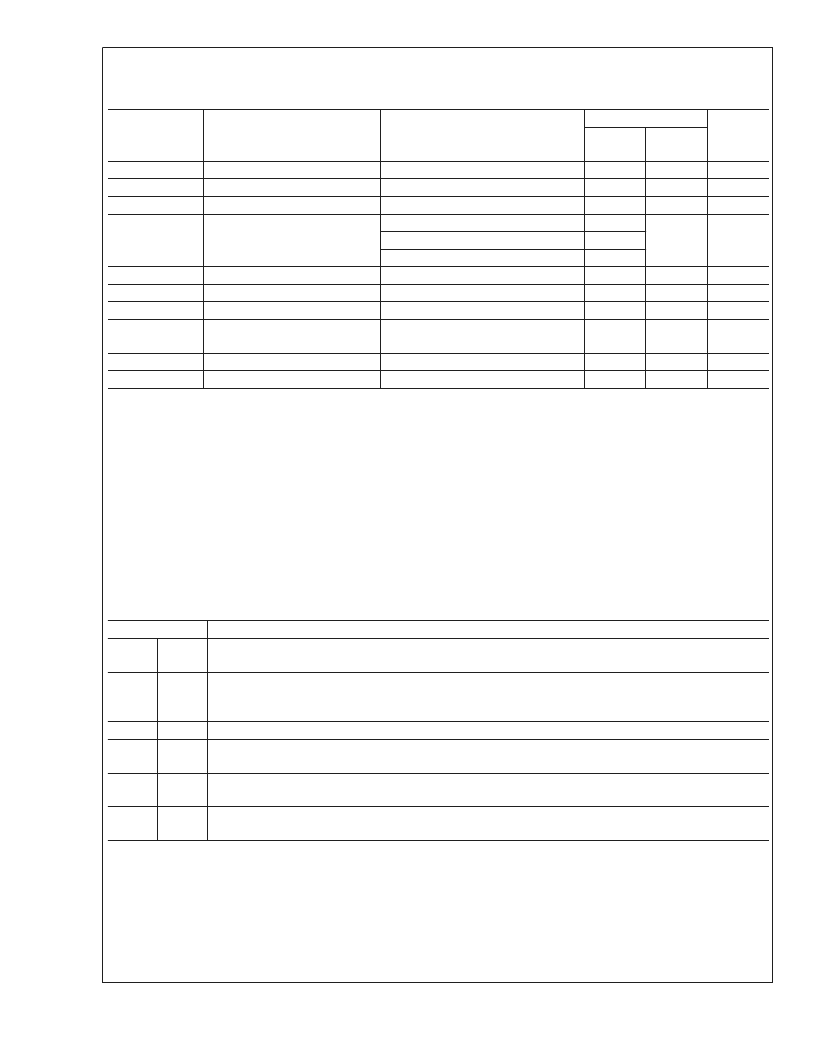- 您現(xiàn)在的位置:買賣IC網(wǎng) > PDF目錄385487 > LM4912 (National Semiconductor Corporation) Stereo 40mW Low Noise Headphone Amplifier PDF資料下載
參數(shù)資料
| 型號: | LM4912 |
| 廠商: | National Semiconductor Corporation |
| 英文描述: | Stereo 40mW Low Noise Headphone Amplifier |
| 中文描述: | 立體聲耳機(jī)40mW的低噪聲放大器 |
| 文件頁數(shù): | 4/14頁 |
| 文件大小: | 699K |
| 代理商: | LM4912 |

Electrical Characteristics V
DD
= 2.4V
(Notes 1, 2)
The following specifications apply for V
DD
= 2.4V, R
L
= 16
, C
O
= 100μF, and C
B
= 4.7μF unless otherwise specified. Limits
apply to T
A
= 25C.
Symbol
Parameter
Conditions
LM4912
Units
(Limits)
Typ
(Note 6)
1.5
0.1
1.5
Limit
(Note 7)
3
2.0
3
I
DD
I
SD
I
M
Quiescent Power Supply Current
Shutdown Current
Mute Current
V
IN
= 0V, I
O
= 0A
V
SHUTDOWN
= GND
V
MUTE
= V
DD
THD = 1%; f = 1kHz
mA (max)
μA (max)
mA (max)
P
O
Output Power
mW
R = 16
R = 32
25
12
10
65
2
V
NO
PSRR
T
WU
V
OSD
Output Noise Voltage
Power Supply Rejection Ratio
Wake Up Time from Shutdown
Output Voltage Change on
Release from Shutdown
Time to Un-Mute
Mute Attenuation
BW = 20 Hz to 20kHz, A-weighted
V
RIPPLE
= 200mV sine p-p
μV
dB
s
1
mV (max)
T
UM
A
M
0.01
80
0.02
s (max)
db
f = 1kHz
Note 1:
All voltages are measured with respect to the GND pin unless otherwise specified.
Note 2:
: Absolute Maximum Ratings indicate limits beyond which damage to the device may occur. Operating Ratings indicate conditions for which the device is
functional but do not guarantee specific performance limits. Electrical Characteristics state DC and AC electrical specifications under particular test conditions which
guarantee specific performance limits. This assumes that the device is within the Operating Ratings. Specifications are not guaranteed for parameters where no limit
is given, however, the typical value is a good indication of device performance.
Note 3:
: The maximum power dissipation must be derated at elevated temperatures and is dictated by TJMAX,
θ
, and the ambient temperature, T
. The
maximum allowable power dissipation is P
= (T
JMAX
- T
A
)/
θ
JA
or the number given in Absolute Maximum Ratings, whichever is lower. For the LM4912, see
power derating currents for more information.
Note 4:
Human body model, 100pF discharged through a 1.5k
resistor.
Note 5:
Machine Model, 220pF-240pF discharged through all pins.
Note 6:
Typicals are measured at 25C and represent the parametric norm.
Note 7:
Limits are guaranteed to National’s AOQL (Average Outgoing Quality Level).
Note 8:
Datasheet min/max specification limits are guaranteed by design, test, or statistical analysis.
Note 9:
10
Terminated input.
External Components Description
See (
Figure 1
)
Components
1.
Functional Description
R
I
Inverting input resistance which sets the closed-loop gain in conjunction with R
f
. This resistor also forms a
high-pass filter with C
i
at f
c
= 1/(2
π
R
i
C
i
).
Input coupling capacitor which blocks the DC voltage at the amplifier’s input terminals. Also creates a
high-pass filter with R
i
at f
c
= 1/(2
π
R
i
C
i
). Refer to the section
Proper Selection of External Components,
for
an explanation of how to determine the value of C
i
.
Feedback resistance which sets the closed-loop gain in conjunction with R
i
.
Supply bypass capacitor which provides power supply filtering. Refer to the
Power Supply Bypassing
section for information concerning proper placement and selection of the supply bypass capacitor.
Bypass pin capacitor which provides half-supply filtering. Refer to the section,
Proper Selection of Proper
Components
, for information concerning proper placement and selection of C
B
Output coupling capacitor which blocks the DC voltage at the amplifier’s output. Forms a high pass filter with
R
L
at f
o
= 1/(2
π
R
L
C
o
)
2.
C
I
3.
4.
R
f
C
S
5.
C
B
6.
C
o
L
www.national.com
4
相關(guān)PDF資料 |
PDF描述 |
|---|---|
| LM4912MM | Stereo 40mW Low Noise Headphone Amplifier |
| LM4913 | 2W Monaural, 90mW Stereo Headphone Audio Amplifier |
| LM4913MH | 2W Monaural, 90mW Stereo Headphone Audio Amplifier |
| LM4913MM | 2W Monaural, 90mW Stereo Headphone Audio Amplifier |
| LM4917 | Ground-Referenced, 95mW Stereo Headphone Amplifier |
相關(guān)代理商/技術(shù)參數(shù) |
參數(shù)描述 |
|---|---|
| LM49120 | 制造商:NSC 制造商全稱:National Semiconductor 功能描述:Audio Sub-System with Mono Class AB Loudspeaker Amplifier and Stereo OCL/SE Headphone Amplifier |
| LM49120TL | 制造商:NSC 制造商全稱:National Semiconductor 功能描述:Audio Sub-System with Mono Class AB Loudspeaker Amplifier and Stereo OCL/SE Headphone Amplifier |
| LM49120TL/NOPB | 功能描述:音頻放大器 RoHS:否 制造商:STMicroelectronics 產(chǎn)品:General Purpose Audio Amplifiers 輸出類型:Digital 輸出功率: THD + 噪聲: 工作電源電壓:3.3 V 電源電流: 最大功率耗散: 最大工作溫度: 安裝風(fēng)格:SMD/SMT 封裝 / 箱體:TQFP-64 封裝:Reel |
| LM49120TLX | 制造商:NSC 制造商全稱:National Semiconductor 功能描述:Audio Sub-System with Mono Class AB Loudspeaker Amplifier and Stereo OCL/SE Headphone Amplifier |
| LM49120TLX/NOPB | 功能描述:音頻放大器 RoHS:否 制造商:STMicroelectronics 產(chǎn)品:General Purpose Audio Amplifiers 輸出類型:Digital 輸出功率: THD + 噪聲: 工作電源電壓:3.3 V 電源電流: 最大功率耗散: 最大工作溫度: 安裝風(fēng)格:SMD/SMT 封裝 / 箱體:TQFP-64 封裝:Reel |
發(fā)布緊急采購,3分鐘左右您將得到回復(fù)。